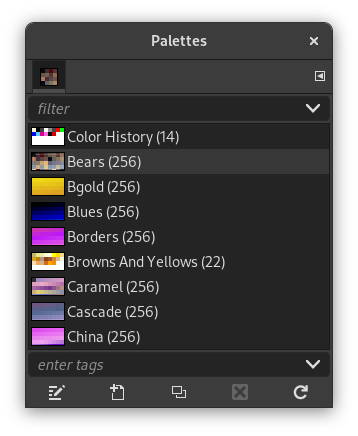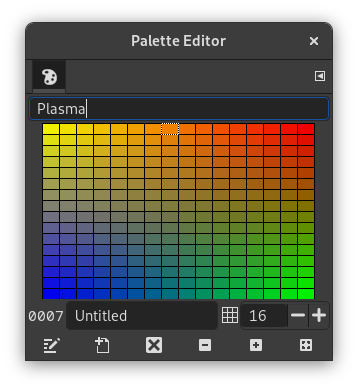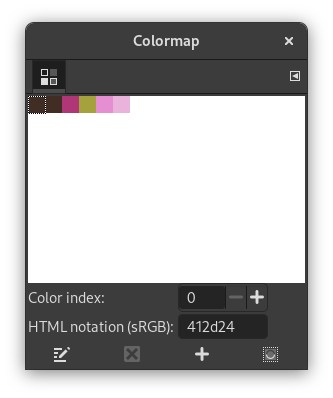A palette is a set of discrete colors. In GIMP, palettes are used mainly for two purposes:
-
They allow you to paint with a selected set of colors, in the same way an oil painter works with colors from a limited number of tubes.
-
They form the colormaps of indexed images. An indexed image can use a maximum of 256 different colors, but these can be any colors. The colormap of an indexed image is called an "indexed palette" in GIMP.
Actually neither of these functions fall very much into the mainstream of GIMP usage: it is possible to do rather sophisticated things in GIMP without ever dealing with palettes. Still, they are something that an advanced user should understand, and even a less advanced user may need to think about them in some situations, as for example when working with GIF files.
When you install GIMP, it comes supplied with several dozen predefined palettes, and you can also create new ones. Some of the predefined palettes are commonly useful, such as the “Web” palette, which contains the set of colors considered “web safe”; many of the palettes seem to have been chosen more or less whimsically. You can access all of the available palettes using the Palettes dialog. This is also the starting point if you want to create a new palette.
Double-clicking on a palette in the Palettes dialog brings up the Palette Editor, showing the colors from the palette you clicked on. You can use this to paint with the palette: clicking on a color sets GIMP's foreground to that color, as shown in the Color Area of the Toolbox. Holding down the Ctrl key while clicking, on the other hand, sets GIMP's background color to the color you click on.
You can also, as the name implies, use the Palette Editor to change the colors in a palette, so long as it is a palette that you have created yourself. You cannot edit the palettes that are supplied with GIMP; however you can duplicate them and then edit the copies.
When you create palettes using the Palette Editor, they are automatically
saved as soon as you exit GIMP, in the
palettes
folder of your personal GIMP directory.
Any palette files in your
directory, or in the system palettes
directory created when GIMP is installed, are
automatically loaded and
shown in the Palettes dialog the next time you start
GIMP. You can also
add other folders to the palette search path using the
Palette Folders
page of the Preferences dialog.
GIMP palettes are stored using a special file format, in files with the extension .gpl. It is a very simple format, and they are ASCII files, so if you happen to obtain palettes from another source, and would like to use them in GIMP, it probably won't be very hard to convert them: just take a look at any .gpl and you will see what to do.
Confusingly, GIMP makes use of two types of palettes. The more noticeable are the type shown in the Palettes dialog: palettes that exist independently of any image. The second type, indexed palettes, form the colormaps of indexed images. Each indexed image has its own private indexed palette, defining the set of colors available in the image: the maximum number of colors allowed in an indexed palette is 256. These palettes are called “indexed” because each color is associated with an index number. (Actually, the colors in ordinary palettes are numbered as well, but the numbers have no functional significance.)
The colormap of an indexed image is shown in the Indexed Palette dialog, which should not be confused with the Palettes dialog. The Palettes dialog shows a list of all of the palettes available; the Colormap dialog shows the colormap of the currently active image, if it is an indexed image – otherwise it shows nothing.
You can, however, create an ordinary palette from the colors in an indexed image—actually from the colors in any image. To do this, choose from the right-click popup menu in the Palettes dialog: this pops up a dialog that gives you several options, including the option to import the palette from an image. (You can also import any of GIMP's gradients as a palette.) This possibility becomes important if you want to create a set of indexed images that all use the same set of colors.
When you convert an image into indexed mode, a major part of the process is the creation of an indexed palette for the image. How this happens is described in detail in Section 6.6, “Indexed mode”. Briefly, you have several methods to choose from, one of which is to use a specified palette from the Palettes dialog.
Thus, to sum up the foregoing, ordinary palettes can be turned into indexed palettes when you convert an image into indexed mode; indexed palettes can be turned into ordinary palettes by importing them into the Palettes dialog.






